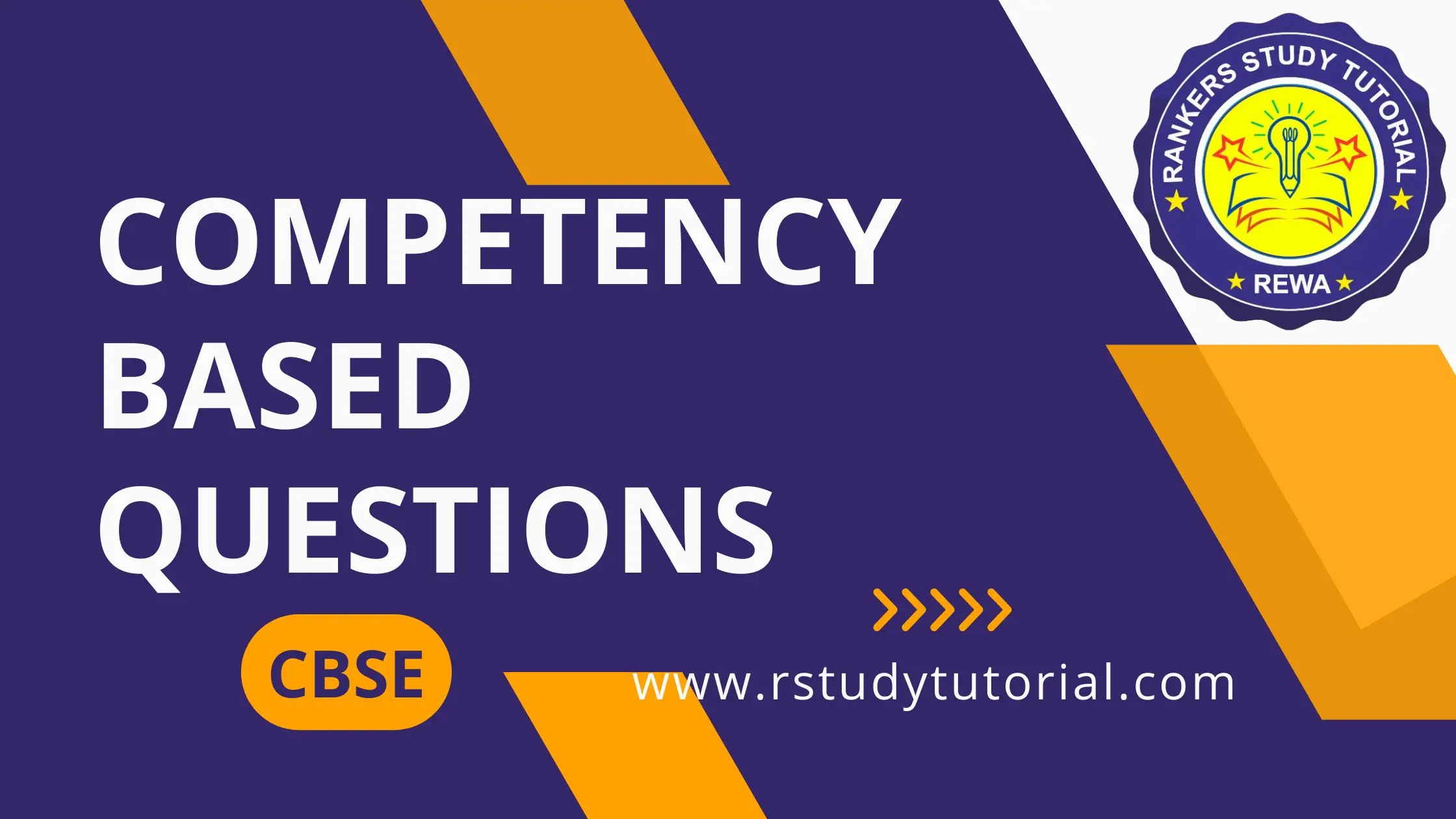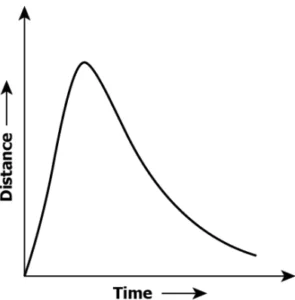Hint: Differentiate between the distance and displacement and calculate them in real situations.
Question.1. A boy walks 10m in straight path moving away from a lamp pole in a garden and walks 5m back on the same path. What is the displacement of the boy from the lamp pole?
(a) 0 m
(b) 5 m
(c) 10 m
(d) 15 m
Question.2. A car travels 5 km towards north than turns right and travels 3km further, the car again turns right and travel 1 km and comes to rest. What is the distance travelled and displacement of the car?
(a) Distance: 5km and Displacement: 9km
(b) Distance: 9km and Displacement: 5km
(c) Distance: 9km and Displacement: 7km
(d) Distance: 7km and Displacement: 9km
Ans.1. (b) 5 m
Ans.2. (b) Distance: 9km and Displacement: 5km
Hint: Calculate and compare speed of an object at different intervals of time and differentiate between uniform and non-uniform motion.
Question.3. Two cars X and Y are travelling along a straight road. The two cars are said to be in uniform motion when:
(a) the two cars travel with same speed
(b) they continuously travel along the straight road
(c) the speed of the cars reduces with the same rate
(d) the two cars travels equal distance in equal interval of time
Question.4. The table shows the distance covered by three cars A, B and C at different time of a day.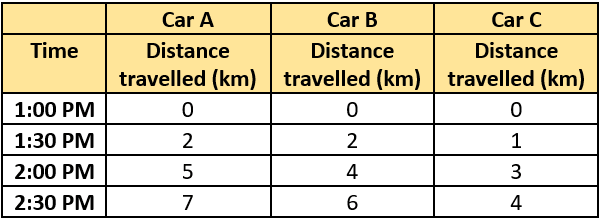
(a) 


Ans.3. (d) the two cars travels equal distance in equal interval of time
Ans.4. (b)
Hint: Calculate average speed of an object.
Question.5. A car travels 3 km of distance in 10 minutes to reach the destination. On the return journey, the car travels the same distance in 15 minutes. What is the average speed of car in entire journey?
(a) 3 m/s
(b) 4 m/s
(c) 5 m/s
(d) 6 m/s
Question.6. A student completes his journey from his house to school with an average speed of 5 m/s in 10 minutes. If the student travels with the speed of 5 m/s in first 4 minutes. What will be its speed in next 6 minutes?
(a) 5 m/s
(b) 7.5 m/s
(c) 10 m/s
(d) 12.5 m/s
Ans.5. (b) 4 m/s
Ans.6. (a) 5 m/s
Hint: Distinguish between speed and velocity and calculate average velocity.
Question.7. A car travels on a straight road with a velocity of 25 km/hour in first one hour and in the next one hour it changes its speed to 35 km/hour. What is the average velocity of the car?
(a) 5 km/hour
(b) 10 km/hour
(c) 30 km/hour
(d) 60 km/hour
Question.8. A student jogs on the track of 150m long. The student starts jogging on the track and reaches the end of the track in 1 minute 30 seconds and comes back to the middle of the track in 1 minute. What is the average velocity of the student?
(a) 0 m/sec
(b) 0.5 m/sec
(c) 1.25 m/sec
(d) 1.5 m/sec
Ans.7. (c) 30 km/hour
Ans.8. (b) 0.5 m/sec
Hint: Define accelerated motion and compute the change in velocity of a moving object in a non-uniform motion.
Question.9. A person rides a motor bike at the speed of 30 m/s. The person applies the brake and the velocity of motor bike comes down to 20 m/s in 3s. What is the magnitude of acceleration of motor bike?
(a) – 3.3 m/sec
(b) – 6.6 m/sec
(c) 10 m/sec
(d) 16.6 m/sec
Question.10. A car is travelling on a path Badhe tables show the velocity of a car on each path at different intervals of time.
(a) 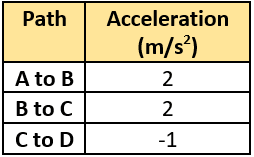
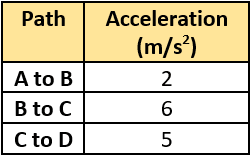
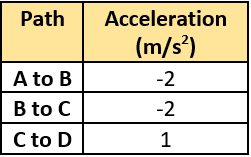
Ans.9. (a) – 3.3 m/sec
Ans.10. (a)
Hint: Plot distance-time graph for a moving object and determine its speed, velocity,
acceleration.
Question.11. Which distance time graph is representing an object in uniform motion?
(a) 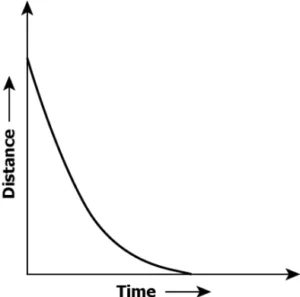
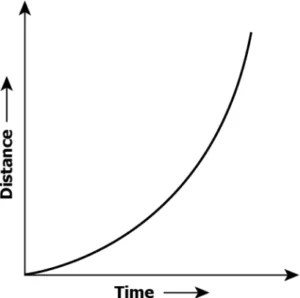

Question.12. The graph shows the distance travelled by a car and the time taken by the car. 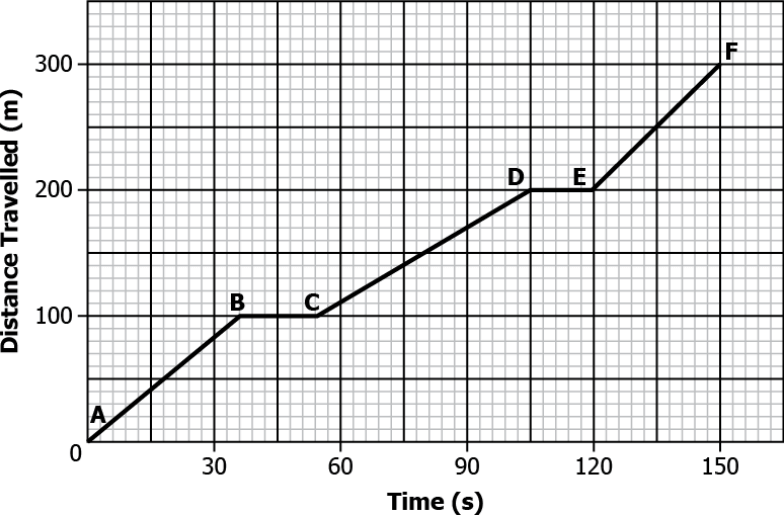
(a) A to B
(b) B to C
(c) C to D
(d) E to F
Ans.11. (c) 
Hint: Construct velocity-time graphs and interpret them to determine speed, velocity, acceleration.
Question.13. The area under the velocity-time graph of a body gives:
(a) speed of the body
(b) retardation of the body
(c) acceleration of the body
(d) distance travelled by the body
Question.14. The graph shows the change in velocity of a car with time.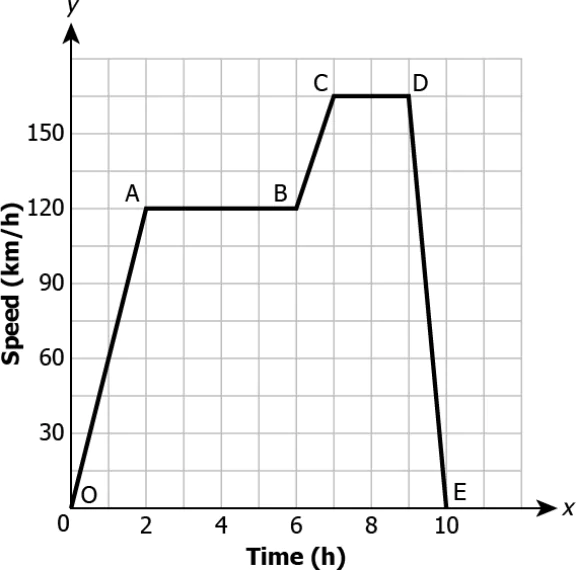
(a) OA
(b) AB
(c) CD
(d) DE
Ans.13. (d) distance travelled by the body
Ans.14. (d) DE
Hint: Extrapolate velocity-time graphs to derive velocity-time, position-time & position-velocity relations.
Question.15. The graph shows the rate of change of the speed of the car.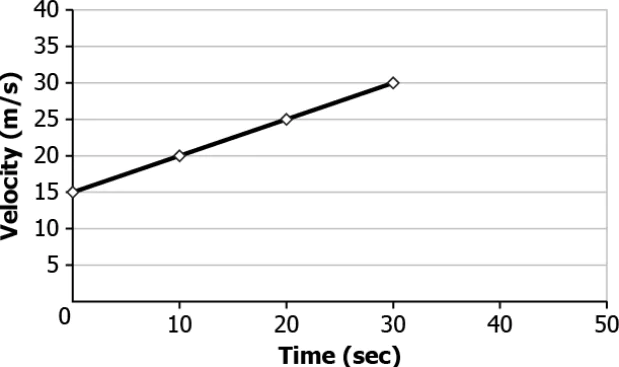
(a) 15 m/s
(b) 20 m/s
(c) 35 m/s
(d) 40 m/s
Question.16. The graph shows the rate of change of speed of a train.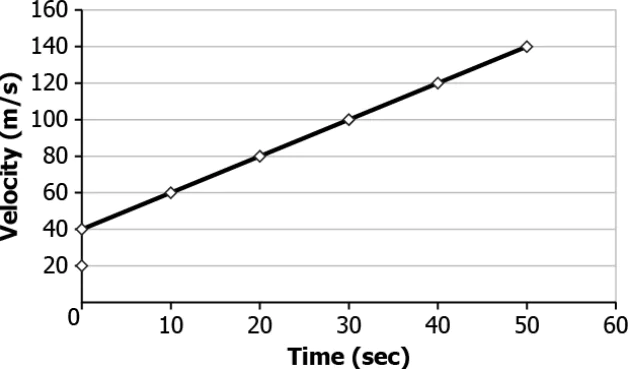
(a) 2000 m
(b) 4500 m
(c) 6000 m
(d) 8500 m
Ans.15. (c) 35 m/s
Ans.16. (c) 6000 m
Hint: Calculate speed of an object traveling in a uniform circular motion.
Question.17. A student ties a stone to a thread of length 1m and starts swinging it in a circular motion. The stone completes 20 rotations in 10 seconds. With what speed the stone is moving?
(a) π m/sec
(b) 2π m/sec
(c) 4π m/sec
(d) 8π m/sec
Question.18. A cyclist riding a bicycle at a constant speed of 10 m/s on a circular track. The cyclist completes the three rounds of a track in 6 minutes. What is the radius of the circular track?
(a) 191 m
(b) 573 m
(c) 1200 m
(d) 3600 m
Ans.17. (c) 4π m/sec
Ans.18. (a) 191 m

